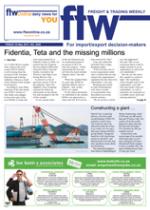At a high-level media
briefing at the Durban
container terminal (DCT),
Transnet launched and
cleverly demonstrated the
capabilities of its seven new
ship-to-shore (STS) cranes
working at full tandem-lift
capacity.
The DCT, said minister
of public enterprises,
Malusi Gigaba, is a vital
component in the SA port
infrastructure, and an
equally vital part of the
Gauteng-Free State-Durban
corridor. Its development is
one means of increasing the
Port of Durban’s container
handling capacity from the
current 3.6 million to 12m
TEUs in the next 30 years.
In turn, the new cranes
speed up the waterside
productivity of the DCT,
which for years has been
challenged, mainly due
to the use of old and
outdated equipment, and the
resultant high probability of
equipment breakdown .
Gigaba added that this
new equipment could
simultaneously handle two
12-metre (40-foot) or four
6m (20ft) containers, and
lift up to a maximum of
80 tons – making them the
biggest in Africa and able
to handle new generation
vessels with 24 containers
stowed across the deck.
The acquisition of these
seven cranes is part of a
programme that will, over
the next 20 years, add 39
new cranes to the current
SA fleet of 45 units at all
the terminals – including
STS, bulk and breakbulk
facilities.
The new cranes, costing
a total of R700 million,
were supplied by Chinabased
original equipment
manufacturer, ZPMC,
following a competitive
tender process in 2011.Of
the eight tenderers, said
TPT CE, Karl Socikwa,
ZPMC was the only
supplier that could offer
tandem-lift units and
deliver them in time to meet
TPT’s requirement.
Referring to the
exhibition to the media
of the tandem-lift cranes,
Gigaba said: “The
capabilities of these STS
cranes will see a massive
jump in productivity, with
gross crane moves per hour
(GCH) – a key measure of
terminal efficiency and how
well equipment is used –
jumping from the current
26 to 33 GCH over the next
three years. This is a 27%
improvement.
“Ship working hour
(SWH) – the rate at which
a terminal is able to load
and offload container
ships in an hour, and a
key consideration for
our customers – will
improve from the current
68 to 85 containers once
our operators are fully
conversant with operating
the equipment.”
This will allow newergeneration
vessels with
larger parcel sizes to call
at our ports – and that will
be a 25% increase, Gigaba
added.
CAPTION
The new cranes ... speeding up waterside productivity.

